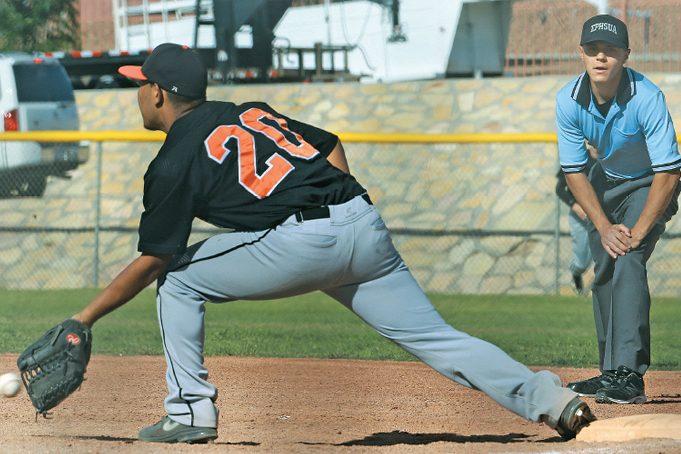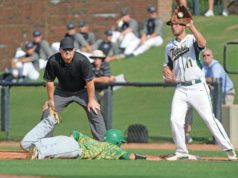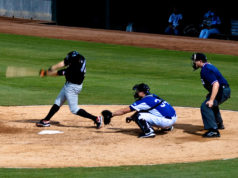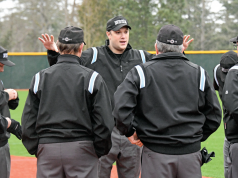When an article says that using your eyes properly will improve your umpiring skills, your immediate reaction is probably, “No kidding.” But upon closer inspection, it’s likely you can make a few tweaks to where you look and when, that will improve your view of the play and help you make better calls.
Improve Your View At First Base
A play on the batter-runner at first base is one of the most common situations where proper use of the eyes can make the difference between getting a difficult call right and having to deal with the argument that follows a blown call. Whether taking a play at first from position A or sliding into position from B or C to make the call, umpires need to get set and focus their eyes on the front edge of the bag as the throw comes to the first baseman. It then becomes a matter of hearing the ball hit the first baseman’s mitt and determining if that came before or after the batter-runner’s foot hit the bag.
Where do your eyes go next? If the throw to the first baseman is in the dirt or high, umpires may have to rule on catch/no catch by the first baseman. That requires the umpire’s eyes to go directly to the ball after the runner has reached the bag. If the throw pulls the first baseman away from the bag, the umpire’s eyes have to stay on the bag to first determine if the ball was caught before the first baseman’s foot came off the bag. A throw toward the plate side of first base may result in a swipe tag that will require the umpire’s eyes to move to the ball in the first baseman’s glove. That may also require a quick read step to get a better viewing angle on the possible tag.
Improve Your View Of A Double Play
Another play situation on the bases where proper use of the eyes looms large is on the front end of a double play at second base. As is the case on most forceplay judgments, it’s important to have your body set and not to be too close to the play. However, without proper use of the eyes, even being far enough away to have the proper perspective may not be enough to prevent the umpire from missing key aspects of the play.
The umpire’s eyes will start on the bag. While the umpire listens for the ball to hit the fielder’s glove, his or her eyes need to move up to the ball as the fielder makes the exchange from catch to throw. If the ball falls to the ground, a judgment may be needed on whether there was an initial catch by the fielder and the ball came loose on that exchange. In games where there are more than two umpires, the base umpire will then need to move his eyes to the sliding runner in relation to the fielder. The force-play slide rule will require a good look at the direction of the slide into the bag and whether contact was made that altered the play.
Proper use of the eyes requires good timing. Any time a tag play occurs, umpires are often anxious to sell the out call with an emphatic voice and demonstrative signal. However, if your eyes aren’t fixed on the ball’s location after seeing the tag, that out signal might be made while the baseball is on the ground instead of the fielder’s glove.
Improve Your View Of A Catch/No Catch
When viewing a potential catch, an umpire’s body should be set. That allows the umpire’s eyes to work at their best. Movement can distort the umpire’s view of what happened. Umpires, particularly base umpires who decide to go out to the outfield to rule on a catch/no catch situation, should be mindful of that.
After reading the ball off the bat, the umpire’s eyes should go to the reaction of the fielder to whom the ball is headed. The fielder’s reaction, not the flight of the ball, is the best place for the umpire’s eyes to help judge whether to go out.
If the decision is made to go out, being stopped and set at the moment when the attempted catch is about to be made will give an umpire’s eyes the best opportunity to see the play clearly and make the right determination. Some umpires believe that continuing to run hard toward the play to get as close as possible will make the play easier to see. However, the closer proximity gained from continuing to run toward the fielder will not compensate for the distortion caused by a moving head. As with plays on the bases, if the umpire sees a catch, his or her eyes should stay on the fielder’s glove to make sure any release of the ball is voluntary.
Umpires who are on the foul line when a long fly ball is hit over their heads face a huge challenge to the use of their eyes. Attempting to follow the flight of the baseball from the bat through the air all the way to a possible home run ruling is a very difficult thing to do. Umpires are better off taking their eyes off the ball, refocusing their vision on the foul pole and then repicking up the ball in time to judge its relationship to the pole as it goes out of play.
Improve Your View When Plate Umpire
Plate umpires will also find that a still head will allow their eyes to better track the ball from the pitcher’s hand to the catcher’s mitt and make the ball/strike judgment easier. However, there are other important plate responsibilities where proper use of his eyes is critical. Since plate umpires have primary responsibility for judging a checked swing, moving their eyes from the location of the pitch to the bat as soon as possible is necessary to make that ruling properly. When their eyes have determined that the pitch will be out of the strike zone, plate umpires can afford to move their eyes immediately to the hitter. On borderline pitches, plate umpires will have to keep their eyes fixed longer on the pitch’s relationship to the strike zone. Fortunately, the rules allow plate umpires to get help from their partner(s) on that difficult call.
Additionally, judging whether the catcher caught a foul tip will require effective use of the eyes. Staying with the catcher’s mitt when the plate umpire hears the ball tipping off the bat is crucial, especially if the catcher is coming up throwing. If the catcher drops the ball, the plate umpire must determine whether the ball came out on the exchange. With two strikes on the batter, that could mean the difference between strike three or just a routine foul ball.
When working with young umpires, I always suggest that they keep their eyes forward when making a strike call. Many of them have seen plate umpires who will look away from the plate to the direction their right arm is pointing when making a strike signal and want to emulate that look. However, if the catcher comes up attempting to throw out a stealing runner or to pick off a runner straying too far from a base, a batter interference call may have to be made. It’s difficult to see all the elements of the play if you are pulling your eyes back after straying away from the plate area. That can be a tough enough call to make when your eyes stay forward throughout the action.
Base umpires who are positioned on the respective foul lines sometimes find it difficult to pick up the baseball off the bat of the hitter. When that happens, the issue may be that they are attempting to follow the ball from the pitcher’s hand to the hitter and then adjusting to the ball’s immediate change of direction. With the high exit speed balls are making in that turnaround, it’s no wonder the ball is hard to pick up. Move your eyes directly to the hitter as soon as the pitch is released. You can pick up the ball when it gets to the plate area. That will make it easier to pick up the ball off the bat while being better focused to help with a checked-swing appeal.
What's Your Call? Leave a Comment:
Note: This article is archival in nature. Rules, interpretations, mechanics, philosophies and other information may or may not be correct for the current year.
This article is the copyright of ©Referee Enterprises, Inc., and may not be republished in whole or in part online, in print or in any capacity without expressed written permission from Referee. The article is made available for educational use by individuals.


















